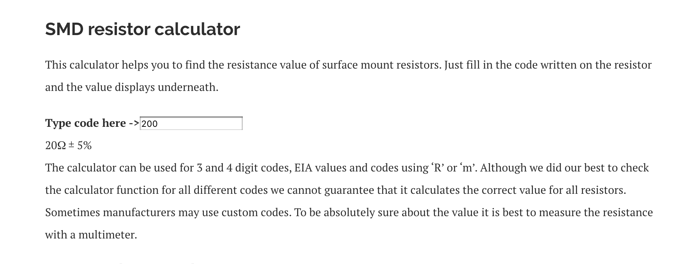I see in the parts list the 20 Ohm resistor is referenced as 0.5%. An original version 5 unit seems to utilise 5% ( Resistor code 200 ) - is there any reason for the difference? Would this difference impact CT accuracy?
i Believe you are mistaken. Please post your source for this assertion.
Using the following site
My unit does have 200 code SMD resistors ( not sure you need a photo of device ? )
That’s the extent of your research? Type a code into a website and regurgitate what it tells you? Let me ask you, what would be the code for a 0.5% resistor?
Im not doing research, was merely checking the components. Is the website infact incorrect?
You make the accusation that the units I sell are not as specified, and when called on it you tell me that you are too lazy to back up your claims. That doesn’t pass the laugh test for responsible conduct.
Please cut your emotion. I am not making any accusations. I am merely asking a very simple question. I was curious to check the parts list and on first look found a website ( which seemed reputable ) and the “200” code “regurgitated” a value of 5%. Im judging by your response that their website is in-fact wrong and asked for your confirmation thereto… nothing personal!! Again - is their website wrong?
A quick Google search turned up this useful bit of information… in other words, “you can’t judge a book by its cover.” 
Tolerance
The standard 3 and 4 digit code does not give us a way to determine the SMD resistor’s tolerance.
In most cases, however, you’ll find that a surface mount resistor marked with the 3-digit code has a tolerance of 5% and a resistor marked with 4-digit code or the new EIA-96 code has a tolerance of 1% or less.
There are many exceptions to this rule, so always check the manufacturer’s datasheet, especially if the component’s tolerance is critical for your application.


